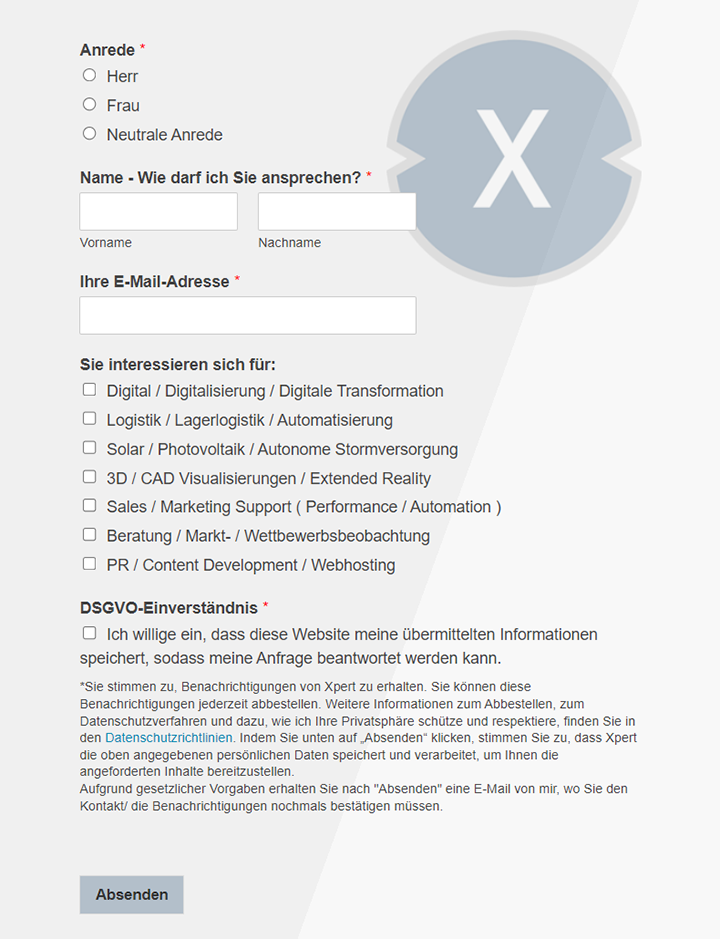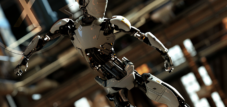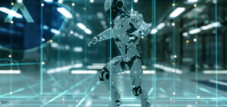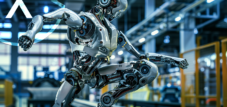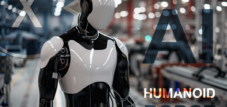Currently the largest humanoid robotics study by Xpert.digital-Marktboom ahead: from robot prototypes to practice
Xpert pre-release
Language selection 📢
Published on: May 13, 2025 / update from: May 13, 2025 - Author: Konrad Wolfenstein

Currently largest humanoid robotics study by Xpert.digital-Marktboom ahead: from robot prototypes to practice-Image: Xpert.Digital
Humanoid robotics: The key to a new industrial revolution? (Reading time: 52 min / no advertising / no paywall)
For the management: overcome Mismatch - why integrated strategies for robots are leadership
Humanoid robotics stand at a turning point and takes the transition from research prototypes to the first commercial implementations, especially in industrial environments. This rapid development is significantly promoted by progress in artificial intelligence (AI), in particular the embodied AI (Embodied AI), large language models (Large Language Models, LLMS) and vision-length action models (VLAS), as well as through innovations in the hardware area. Market forecasts indicate considerable growth, with estimates that range from $ 30 billion to over $ 200 billion by $ 30 billion. The areas of application are diverse and extend from industry to healthcare to personal assistance systems. Despite the enormous potential, there are still significant challenges in areas such as battery technology, manual skill (dexterity), cost efficiency, scalability and ethical governance. The convergence of falling hardware costs, improving AI and increasing shortage of labor creates a kind of “perfect storm” that favors the accelerated introduction of humanoid robots. This could lead to the amortization (Return on Investment, ROI) in targeted industrial applications can be achieved faster than predicted by some conservative estimates, which in turn would result in faster adoption cycles in these niches. Companies will increasingly have incentives to implement automation solutions, and humanoid robots offer an adaptable solution for human -centered environments due to their versatility.
The dual focus on the development of universal AI and highly specialized hardware components (actuators, sensors) leads to a complex interaction. Advances in one area can be slowed down by bottlenecks in the other, which indicates that holistic, integrated development strategies for market leaders will be decisive. For example, a highly developed AI cannot fully compensate for poor mechanical skill or a limited operation time due to battery bottlenecks. Conversely, advanced hardware cannot develop their full potential without sufficient intelligent software. Companies that can develop hardware and AI together, as is the case with Tesla's vertical integration approach, could therefore have a competitive advantage.
This decade (2025-2035) promises to sound a transformative era for humanoid robots that have the potential to change work, society and everyday life.
Suitable for:
- The top ten of the most famous and famous humanoid robots: from Atlas, Sophia, Ameca, Digit, GR-1 to Phoenix to Optimus
Technological breakthroughs: How Humanoid robots change our lives
Humanoid robotics has developed into one of the most dynamic and potentially transformative technology fields of the 21st century. Standing at the interface of artificial intelligence, advanced mechanics, electronics and material sciences, Humanoid robots promise to change the way people work, interact and live. This study offers a comprehensive analysis of the current stand, historical development, the technological foundations, the diverse applications, the market landscape, the central challenges and the future development perspective of humanoid robots with a special focus on the period until 2025 and beyond.
Definition of the humanoid robot
A humanoid robot is by definition a robot that resembles the human body in its external form and typically has a hull, head, two arms and two legs. This human -like shape is not only an aesthetic feature, but often serves functional purposes, such as interaction with tools and environments that were designed for humans, or experimental purposes, for example researching the two -legged locomotion).
Academic definitions go beyond pure physical similarity and emphasize that humanoid robots are carefully constructed in order not only to imitate the human appearance but also human behavior. This includes replication of functions such as perception, decision -making and interaction. Due to their anthropomorphic design, they offer inherent advantages in human -centered environments because they enable more natural interaction and a higher adaptability than other robot forms. The ability to move in rooms created for humans and to deal with tools developed for humans is a core aspect of their functionality and its growing benefit.
The definition of “Humanoid” itself is subject to evolution. Originally, the focus was strongly on the physical figure. However, recent academic considerations and technological progress increasingly shift this focus on imitation of behavior and cognitive functions. This development is significantly promoted by the progress in artificial intelligence. If humanoid robots not only look human, but also increasingly “act” and “conclude”, this, this reduces the interaction barriers, but at the same time raises more profound ethical questions regarding deception, emotional attachment and nature of intelligence.
Significance and scope of the study
Humanoid robotics represents a critical technological limit and embodies the convergence of various scientific and technical disciplines. Their potential to revolutionize industries, to counteract the shortage of labor, to assist in dangerous work and to improve daily life is immense. The “functional purpose” of the humanoid design - interaction with human tools and environments - is developing into a primary economic driver. This adaptability means that companies can integrate humanoid robots into existing work processes with lower disorders and capital expenses than would be the case when redesigning factories or warehouses for specialized robots. This inherent advantage is a strong sales argument, as pilot programs in the automotive industry and logistics show, and acts as a strong catalyst for acceptance.
This study aims to provide a comprehensive analysis of the current stand (approx. 2025), the historical context, the technological basics, applications, the market landscape, the challenges and the future development paths of the humanoid robotics. It is intended to serve as a well -founded resource for researchers, developers, political decision -makers, investors and the general public to understand the complexity and the far -reaching implications of this emerging technology.
Historical development of humanoid robotics
The fascination for artificial beings that resemble humans goes far back into history and has significantly shaped the development of humanoid robotics. From ancient myths to today's highly developed machines, a further arc of human striving, intelligence and movement in a human -like form spans.
Early concepts and machines
The idea of human -like artificial beings can already be found in antique myths such as those of Hephaistos, which created mechanical servants, or Pygmalion, whose statue awakened to life. Early mechanical constructions, so -called machines, testify to this early interest. Examples of this are Egyptian water clocks with movable human figures that beat the hours, the mechanical birds and horses of the Chinese engineer King-Shu Tse (approx. 400 BC) or the programmable musicians from al-Jazarī in the 12th century. Leonardo da Vinci's sketches of a mechanical knight from the late 15th century, which was able to move arms, heads and jaws, also belong in this series of concepts. These early examples demonstrate a long -lasting human fascination for the creation of artificial beings and laid the conceptual foundation for later developments.
Historical milestones of robot development (pre-1970 and important theoretical/early practical steps in the 20th century)

Historical milestones of robot development (pre-1970 and important theoretical/early practical steps in the 20th century)-Image: Xpert.digital
The historical development of robotics before 1970 is characterized by numerous milestones and theoretical progress. Already around 3500 BC In Greek mythology by the myths of Hephaistos and Pygmalion, the first ideas of intelligent mechanisms and artificial beings were described. Around 1500 BC The Egyptians developed water clocks with humanoid figures that represented the first approaches of mechanical automation. In 1206 AD, Ismail al-Jazarī constructed an early form of programmable humanoid robots with his musician boat. Leonardo da Vinci designed in 1495 AD sketches of a mechanical knight who was able to sit down and move the head and arms. In 1769, Wolfgang von Kempelen developed the “shaft türken”, a humanoid -released machine that could play chess, although this was controlled by a hidden person.
In 1920/1921 Karel Čapek introduced the term “robot” in his play “Rur”, inspired by the Czech word “robota”, which means “forced labor”. At the 1939 world exhibition, Westinghouse Electric presented the robot “Elektro”, which could speak and react to commands. In the 1940s, George Devol developed the “Unimate” industrial robot, which revolutionized industrial production by automating repetitive tasks. In 1942, Isaac Asimov formulated the well-known “three laws of robotics” in his science fiction stories, the ethical guidelines for dealing with robots.
In 1948, Norbert Wiener published his groundbreaking work “Kybernetik”, which addressed the regulation and communication in machines and living things and thus strongly influenced the development of robotics. In the same year, William Gray Walter created the autonomous robots “Elmer” and “Elsie”, who were able to react to environmental changes. Finally, in 1950, Alan Turing presented a concept with the Turing test that should examine the ability of a machine to show intelligent behavior that cannot be distinguished from that of a person.
The 20th century: departure to modern robotics
The 20th century marked the beginning of modern robotics, characterized by theoretical foundations and initial practical realizations. The term “robot” was characterized in 1920/1921 by Karel Čapek in his play “Rossum's universal robot), derived from the Czech word“ Robota ”, which means forced labor. An formerly known humanoid robot was “Elektro”, which was presented in 1939 at the New York World Exhibition of Westinghouse and was able to react to voice commands and to speak simple sentences. Isaac Asimov made an important contribution to the ethical discussion with his “three laws of robotics” (1942) and popularized the term “robotics” as a science of robots. At the same time, pioneers like Norbert Wiener laid important theoretical and practical foundations with his early autonomous robots (1948) with his work on Kybernetik (1948) and William Gray Walter. Alan Turing's publication of the Turing Test (1950) offered a conceptual framework for the evaluation of machine intelligence. Although not Humanoid, the development of the first industrial robot, Unimate, was a crucial step in automation technology in the 1940s to 1960s and revolutionized industrial production. This period was characterized by an intensive literary and scientific examination of the social, ethical and technological challenges of robotics.
Important milestones after 1970: The rise of functional humanoiders
After 1970, the era of functional humanoid robots began, which were able to fulfill increasingly complex tasks.
- Wabot-1 (1972-1973, Waseda University): This robot is considered the world's first fully functional, intelligent humanoid robot. Developed with the aim of creating a “personal robot”, Wabot-1 was able to go, communicate with a person in Japanese, measure distances and directions to objects with artificial eyes and ears as well as grab and transport objects with his hands.
- Wabot-2 (1984, Waseda University): Designed as a “special robot”, Wabot-2 was a humanoid musician who could read grades and play on an electronic organ.
- Honda E-series (1986-1993) & P series (1993-1997): Honda did pioneering work in the bipedal locomotion. The E-series served basic research, while the P series led to more advanced prototypes. P2 (1996) was the first self -regulating, two -legged robot, and P3 (1997) the first completely independent bipedal humanoid robot that could go without external cables.
- Asimo (2000, Honda): As a Hondas eleventh bipedal humanoid robot, Asimo was able to run, interact and perform semi-autonomous tasks. An improved version was presented in 2011. Asimo was included in the Robot Hall of Fame in 2004. The development was discontinued in 2018 and Asimo 2022 officially “retired”. The setting of projects such as ASIMO does not necessarily signal a failure, but often a strategic realignment towards more practical or more economically profitable applications. This reflects a market maturity in which research and development investments increasingly have to be geared towards concrete market needs and profitability.
- HRP series (Japan, Aist/Kawada): The Humanoid Robotics Project (HRP) started modified Honda P3 robots and further developed them. HRP-2 (2002) was a bipedal robot. HRP-4C “Miim” (2009) was a feminine designed robot who could sing and dance.
- Actroid (2003, Osaka University/Kokoro): This robot was characterized by a realistic silicone skin and focused on a human -like appearance.
- Hubo (2005, Kaist): Was South Korea's first walking humanoid robot.
- NAO (2006, Aldebaran Robotics/Softbank): A small, programmable humanoid robot with open source approaches that found extensive distribution in research and teaching.
- Atlas (2013-today, Boston Dynamics): Originally developed for the Darpa Robotics Challenge, Atlas is a highly dynamic humanoid robot that can carry out complex movements such as walking, running, jumping and reversing. A fully electric version with improved skill was presented in April 2024. The Darpa Robotics Challenge acted as an important catalyst that expanded the borders of humanoid skills in disaster scenarios and promoted innovations that are now incorporated into commercial products. The advanced mobility and robustness developed for these challenges are now characteristics of commercial or standard robots.
- Valkyrie (2013, NASA): Also developed for the Darpa Robotics Challenge, Valkyrie was designed for use in damaged surroundings created by humans and harbors potential for space missions.
- The latest remarkable developments (after 2020):
- Ameca (Engineered Arts, 2022): known for his extremely expressive face.
- Optimus (Tesla, 2022): An all-purpose-humanoid that is developed for use in manufacturing and potentially in the household.
- UNITREE G1 (2024): A relatively inexpensive humanoid robot.
- Figure 01/02 (Figure AI): All-purpose-humanoids that are already tested in industrial pilot projects.
Historical development shows a significant change from university -guided basic research (e.g. Waseda, Hondas Early Work) towards commercially driven development with specific application goals (e.g. Teslas Optimus for manufacturing, agilities digit for logistics). This indicates the increasing maturity of the field and the growing economic profitability.
Core technologies and components
The skills of humanoid robots are based on a complex interaction of various nuclear technologies and components. These range from mechanical systems that provide movement and structure, to the perception of the environment to sophisticated software and AI architectures, enable control, learning and interaction. The development in each of these areas is crucial for the progress of the entire humanoid robotics.
Mechanical systems
The mechanical systems form the physical foundation of humanoid robots and include actuators for movement, materials for the structure and energy systems for operation.
Activity
Autators are the engines that are responsible for movement in the robot and imitate the function of human muscles and joints. Ideal actuators should have a high power density, low mass and small dimensions.
- Electric actuators: They are the most widespread species and typically smaller. For joints in human size, however, several electrical actuators per joint may be required to generate enough strength (e.g. HRP-2). Progress in permanent magnets (e.g. neodyme-iron boron) significantly increased the power-density of electrical engines and reduced the distance to hydraulic systems. Electrical actuators are characterized by high efficiency (75-80%), a lower number of components and a lower maintenance effort compared to hydraulic systems. The trend towards electrical actuators, even with highly dynamic robots such as the new Atlas, signals a market maturity that aims to use commercial profitability (efficiency, maintenance, costs) and not just to raw top performance. This will accelerate the introduction to industrialists and potentially in consumer applications.
- Hydraulic actuators: These offer higher performance and better torque control, but can be very bulky (e.g. the original atlas). Electrohydraulic actuators (EHA) are a solution to alleviate this size problem. Hydraulic systems have high impact strength, but have lower efficiency (40-55%) and require more maintenance.
- Pneumatic actuators: They work based on the compressibility of gases, a well-known example is the McKibben muscle.
Kawasaki, for example, develops the “Hydro Servo Muscle”, an electrohydraulic actuator that is supposed to offer high shock resistance and power density for its humanoid robot kaleido. Boston Dynamics's decision to make the new Atlas fully electrically indicates a trend towards commercialization and wider applicability.
Comparative analysis of actuator technologies for humanoid robots
The comparative analysis of actuator technologies for humanoid robots shows that electrical actors have high efficiency, good control, low maintenance requirements and compactness, but are limited in maximum strength and with overheating-examples of this are HRP-2, Asimo and the new atlas. Hydraulic actuators offer a very high force, high power density and robustness, but are bulky, inefficient, susceptible to leaks and require complex periphery, as the original Atlas shows. Pneumatic actuators impress with ease, flexibility and cost efficiency, but are difficult to control and need compressed air supply, an example is the McKibben muscle. Electrohydraulic actuators (EHA) combine the strengths of electrical and hydraulic drives, are more compact than purely hydraulic systems, but complex and potentially expensive, as is the case with the planned kaleido.
Materials and structural design
Lightweight structures are crucial for the flexibility, energy saving and a longer battery life of humanoid robots. A high load weight ratio and a high rigidity of the structure are desirable. Methods of evolutionary structural optimization (ESO) are used to significantly reduce the weight of framework structures (in a study by 50.15%) without affecting rigidity or vibration behavior. Magnesium alloys and plastic resins are used as materials, such as with Asimo.
Energy systems (batteries)
The energy supply is one of the greatest challenges. Lithium ions (Li-ion) and lithium iron phosphate (lifepo₄) are common. The Tesla Optimus uses, for example, a 2.3 kWh, 52V system, while the UNITREE H1 uses a 15Ah (0.864 kWh) battery. The Valkyrie battery has a capacity of 1.8 kWh and enables an operation of about an hour.
The central challenges are the limited energy density, which leads to short operating times, the high performance tax required for dynamic actions, the slow loading speed (industrial applications often operate ~ 20 hours, currently more 4-6 hours) and the safety of the batteries under extreme environmental conditions. Advances are expected at semi-solid state and solid-state batteries that promise higher energy density (e.g. Xinwangda with 500 WH/kg, Farasis Energy with> 330 WH/KG, rept with> 400 Wh/kg). Fast charging technologies are also of crucial importance.
Suitable for:
- Humanoid Standing-up Control: Learn to get up with “host” humanoids-the breakthrough for robots in everyday life
Sensor and perception systems
Humanoid robots must perceive their surroundings precisely in order to be able to interact safely and effectively. Perception plays a fundamental role in enabling seamless interaction with people and the surrounding area. The sole dependence on visual systems is not sufficient for complex manipulations and secure interactions in confusing or hidden environments. Therefore, proprioception and tactile sensors develop into the next important limits in sensor technology for humanoids. The limits of visual perception in tasks such as the gripping objects or the use of precise forces drive significant research and development efforts in these other sensory modalities. Success in these areas will open up a new level of manipulative ability.
Visual systems
Cameras (RGB, deep cameras), lidar, radar and ultrasonic sensors are used for environmental recording, object recognition and navigation. The Tesla Optimus relies strongly on cameras (a multi-camera setup similar to its vehicles), while the Atlas of Boston Dynamics Lidar, depth and RGB sensors uses. Valkyrie uses the Carnegie Robotics MultiSense SL system (laser, stereo, IR-structured light) and additional dangerous cameras.
Auditory systems
Microphones serve speech recognition and the recording of ambient noise.
Tactile sensors
This is crucial for manipulation, the recognition of object properties (shape, stiffness, softness) and the safe interaction. It includes strength, pressure, torque, slip and temperature sensors. The human hand has around 17,000 tetret receptors; Replacing this is an enormous challenge. Advances include flexible electronic skin (e-skins) and advanced AI algorithms. Companies like Sanctuary AI (Phoenix Robot), Meta AI (Digit 360 with Gelsight Technology) and Duke University (Soniksense using acoustics) make progress here. Tactile sensors enable the blind to the blind, the detection of slipping and avoiding excessive use of strength, which is particularly important, since many current robot grippers are still simple two-finger or suction systems.
Proprioception
This is the point for your own body position and movement without visual or auditory stimuli and is critical of robust control, especially with soft robots. This is a challenge even for biological systems; This extensive feedback is often missing from current robots. The Kinesoft framework uses, for example, expansion sensor arrays for shape estimate in soft robot hands.
Sensorus and state estimate
The combination of data from multiple sensors (multi-sensor fusion) using techniques such as Bayes' filters and optimization procedures (maximum a posteriori, map) is crucial for a robust internal state estimate and understanding of the external environment. Machine learning is increasingly preferred to regular -based systems.
Software, AI and control architectures
The intelligence and the behavior of humanoid robots are determined by complex software, advanced AI models and sophisticated control architectures. The development of individual components (actuators, sensors, batteries) is increasingly determined by the requirements of AI and learning -based control systems. This creates a feedback loop in which AI progress requires better hardware and enables more complex AI to improve hardware. AI models for complex tasks such as full-body manipulation or agile locomotion require highly reactionable actuators, dense sensory feedback (especially tactile) and sufficient energy. Learning-based approaches benefit, for example, from hardware that is designed for ML compatibility (e.g. simple data acquisition, robust sensors). This Koevolution is essential to overcome current performance plateaus.
Locomotion and dynamic balance
Maintaining the dynamic balance is based on concepts such as the Zero Moment Point (ZMP). Model Predictive Control (MPC) and Whole-Body Control (WBC) are popular approaches to integrate demanding models and to generate compliant movements. The parameter selection remains a challenge, since the manual coordination is very labor -intensive. Methods such as DITTUNE use differentiable programming for automatic coordination. Learning approaches (e.g. Reinforcement Learning) are used for two -legged locomotion and creation.
Manipulation and dexterity
The full body control (Whole-Body Control) coordinates numerous degrees of freedom for complex tasks. The replica of human fine motor skills is an important area of research. The full body manipulation, i.e. the use of any body parts for interaction, is a major challenge. For example, robot robotic robopanoptes uses full-body vision (21 cameras) for full-body dexterity. Learning human demonstrations (imitation learning) is a key approach.
Navigation and surrounding interaction
Scout planning, avoidance of obstacles and self -collision detection are crucial for movement in complex environments. Slam (Simultaneous Localization and Mapping) In combination with Reinforcement Learning (RL), the navigation of mobile robots is used to improve convergence and reduce collisions.
Human robot interaction (HRI) and cognitive skills
LLMS and Vision-Language models (VLMS) improve the logical thinking of robots, the understanding of context and enable more natural, dialog-oriented interactions. Robots are equipped with “personalities” and curious behavior. Challenges are the ambiguity of the language, which can lead to mistakes and the complexity of the illustration of language to physical actions. Fine tuning of LLMS on robot data (Vision Language Action Models-VLAS) is a promising direction.
Learning paradigms and AI models
There is a change in rule -based systems for machine learning (ML) and Deep Learning (DL). Reinforcement Learning (RL) is used for motor skills, as is imitation learning of human demonstrations. The SIM-to-real transfer is crucial for efficient training; The Toddlerbot platform was developed, for example, for ML compatibility and data acquisition. The ultimate goal is artificial general intelligence (AGI), which would enable robots -like learning, logical thinking and adaptability across various tasks without specific preprogramming. The “Black Box” nature of some advanced AI models, especially in the deep learning, is a challenge for security-critical applications and debugging. This requires new approaches to explain and verifying in humanoid control systems. While AI enables unprecedented skills, the difficulty to understand how deep learning models get decisions is a problem, especially for robots that interact with people or work in dangerous environments. This lack of interpretability can hinder security certification and troubleshooting and research into more transparent AI or more robust validation methods.
🎯🎯🎯 Benefit from Xpert.Digital's extensive, fivefold expertise in a comprehensive service package | R&D, XR, PR & SEM

AI & XR 3D Rendering Machine: Fivefold expertise from Xpert.Digital in a comprehensive service package, R&D XR, PR & SEM - Image: Xpert.Digital
Xpert.Digital has in-depth knowledge of various industries. This allows us to develop tailor-made strategies that are tailored precisely to the requirements and challenges of your specific market segment. By continually analyzing market trends and following industry developments, we can act with foresight and offer innovative solutions. Through the combination of experience and knowledge, we generate added value and give our customers a decisive competitive advantage.
More about it here:
Commercialization and potential: the market breakthrough of humanoid robots
Applications of humanoid robots (according to sectors, with focus 2025)
Humanoid robots are increasingly being used in a variety of sectors, with their human -like form and their growing skills predestine them for tasks that have traditionally been carried out by people. By 2025, there are significant progress in testing and first implementation, especially in industrial areas, healthcare and niche applications. The human-like form is a double-edged sword: it facilitates integration into human environments and human-robot interaction (HRI), but also sets high expectations of skill and intelligence, which are currently difficult to meet. This could lead to disappointments if the skills do not promise the anthropomorphic. The human hand has incredible skill, and human intelligence is extremely adaptable. Current robots, although they improve, still have difficulties with fine manipulation and robust operation in unstructured environments. This gap between appearance and actual performance could affect acceptance and the perceived benefit if it is not carefully managed.
Suitable for:
- AI humanoid robots: Qinglong, Optimus Gen2 from Tesla, Kuavo from Leju Robotics and exoskeleton robots from ULS Robotics
Industrial automation (production & logistics)
In industrial automation, humanoid robots promise rationalization of assembly lines, maintenance and inspection work as well as logistics processes.
Manufacturing: Humanoid robots assist human workers in precision tasks, the lifting heavy loads and repetitive activities.
- Case study: BMW & Figure AI: Figure 02 Robots are used in the BMW plant in Spartanburg, South Carolina, for tasks such as the assembly of chassis and transporting parts. According to the first pilot projects in 2024, permanent implementation took place in early 2025. Functional upgrades led to a 400%increase in movement speed by November 2024, which means that the robots can place up to 1,000 components per day. Figure Ai plans to produce 100,000 to 200,000 units in the next four years (2025-2028).
- Case study: Mercedes-Benz & Apptronik: The Apollo robot assisted workers in the production hall.
- Tesla plans to use Optimus robots for tasks such as charging sheets in their own factories, with several thousand units being used to take on meaningful tasks in 2025. BYD aims to use 1,500 humanoids in 2025, with a scaling to 20,000 to 2026.
Logistics & warehousing: Humanoid robots optimize material handling, inventory management as well as picking, packaging and sorting processes.
- Case study: Amazon & Agility Robotics: Amazon tests the robot Digit for handling and recycling containers in its research and development centers as well as warehouses. Digit is designed for 8-hour layers. Amazon also tests Apptronik's Apollo.
- Humanoids can reduce human work in the acceptance of goods and discharge, storage, picking, packaging, labeling, shipping and loading and inventory.
- In early 2025, Idteechex recorded only a limited number of pilot projects (<100 humanoids) in warehouses. A large-scale introduction (thousands of units) is not expected before the end of 2025 due to 18-30-month test cycles. The breakthrough in logistics is expected for 2026-2027.
The most successful applications so far, such as Moxi in hospital logistics and Digit when handling container handling, focus on specific, repetitive tasks in relatively structured environments instead of general autonomy. This indicates a path to broader acceptance: start specializing and then generalized with increasing technological maturity. Moxi carries out deliveries, Digit moves container. These are clearly defined tasks. This approach is in contrast to the vision of all -purpose robots. The success of tasks -specific humanoid provides ROI and generates data to improve general skills, which creates a positive circulation. This gradual approach is more practical than trying to implement a complete ability to complete from the start.
Healthcare and geriatric care
In this sector, humanoid robots offer support for medical personnel, patient care, social support and rehabilitation measures.
Hospital logistics: Moxi from Diligent Robotics is used in over 24 health systems and has carried out almost a million deliveries (laboratory samples, consumption materials), which saves personnel saving and savings. The ROI is evident in an increase in efficiency and reduced burnout rate of the staff. The Robotics-As-A-Service (RAAS) model will probably be a decisive factor for introducing small and medium-sized companies (SMEs) and for the use of humanoids in sectors, in which high preliminary investments represent prohibitive costs, and thus democratize access to progressive robotics. High acquisition costs are a major hurdle. The RAAS model lowers the entry barrier by shifting the costs of investment expenses (CAPEX) to operating expenses (Opex). Moxi's success with this model in healthcare shows its profitability. If humanoids become more powerful, Raas could enable smaller companies or departments to use them without massive initial investments, which could accelerate market penetration.
Elderly care, support & assistance: robots such as Grace (Hanson Robotics), Pepper (Softbank), Nadine, Paro, Elliq, Temi and Toyota HSR offer social interaction, medication memories, health monitoring and support with everyday activities. Studies show positive commitment and emotional support.
Rehabilitation: Humanoids such as Baxter and NAO are used as therapy assistants for stroke patients and children, lead exercises and keep patients in the bar.
Surgical assistance: The DA Vinci Surgical System supports minimally invasive operations.
Space research and dangerous environments
Space research: support of astronauts, implementation of outboard operations (EVAS), preparation of habitats, maintenance on the ISS or future moon/Mars bases. Examples are Nasas Robonaut 2 (first humanoid in space), Valkyrie (designed for Mars missions) and the DLR robot Rollin 'Justin, Agile Justin and Toro. Autonomous operation is crucial due to communication delays. Modular design for repairability is important (e.g. Valkyrie).
Dangerous environments (disaster protection, nuclear area): navigation in dangerous terrain, search and rescue, delivery of relief goods, handling of toxic materials, support in fire fighting. Examples: Atlas by Boston Dynamics (designed for such tasks), Spot in Fukushima Daiichi for exploration, radiation measurement and sampling of rubble. In Fukushima, robots are used to monitor, decontaminate and prepare fuel debris removal.
Personal assistance and budget applications
Humanoid robots should take on household work (cleaning, cooking, laundry) in the future, provide security and serve as a companion. This area is still at a very early stage. Neo Gamma from 1x Technologies was tested in a home environment for tasks such as coffee and cooking assistance (remote controlled). Challenges are unstructured domestic environments, security, costs and the required general intelligence.
Education, entertainment and customer service
Education: Interactive teaching assistants, personalized learning, especially for MINT subjects and students with special needs. Nao from Softbank Robotics is widespread (> 13,000 units in over 70 countries) and is used to teach programming, cultural heritage, mathematical concepts and to support children with autism. Studies show that NAO increases the commitment, but may have user -friendly problems in loud environments.
Entertainment: interactive hosts, actors in themed parks, at events and in the media. Ameca from Engineered Arts is known for lifelike facial expressions. Robothespian is used for theater performances. The market for entertainment humanoids should grow significantly.
Customer service & hospitality: reception staff, information assistants, concierges in retail, hotels and banks. Softbank Pepper was tested as a reception robot in hospitals and in retail.
Up -and -coming and niche applications
Other fields of application include the military and defense (clarification, disposal of ordnance, training simulations) as well as agriculture and construction.
Important areas of application and suitability of humanoid robots (as of 2025)
Important areas of application and the suitability of humanoid robots in 2025 include numerous fields. In industrial production, robots take on tasks such as assembly, parts transport, quality control and moving heavy loads. With projects such as Figure 02 (BMW), Apollo (Mercedes), Optimus (Tesla) and the HRP series, they have achieved an average to high level of maturity, but are still limited by costs, battery life and safety near humans. In logistics and warehousing, humanoid robots are used for picking, sorting and transport. Examples such as Digit and Apollo from Amazon or Cadebot and Junobot show pilothorizons, although there are challenges such as dynamic surroundings or the handling of various objects. In the healthcare system, robots can be found primarily in hospital logistics, where models such as Moxi are established to relieve nursing staff by promoting samples and medication. Humanoids such as Grace and Pepper support everyday assistance in geriatric care, but ethical concerns and data protection issues remain obstacles. For rehabilitation, such as motivating exercises, robots such as Baxter and NAO impulses, but research is still necessary to further adapt the interaction. A pioneer in the area of surgical assistance is this DA Vinci Surgical System, which enables minimally invasive interventions through high precision, but can only be used for specific applications and at high costs.
In space research, robots such as Robonaut 2, Valkyrie or Rollin 'Justin are used to carry out maintenance and habitat preparation in dangerous environments and to minimize the risks for astronauts. Nevertheless, there are challenges in autonomy, robustness and repairability. Robots such as Atlas or Spot perform important services when operating in dangerous environments such as disaster protection or nuclear scenarios. Personal assistance and housekeeping remains experimentally with prototypes such as Neo Gamma, whereby their costs, security and flexibility in unstructured environments still represent hurdles. In education, robots such as NAO and Pepper promote interactive learning and personalized support, while costs and integration into curricula are still challenges. In the entertainment, too, systems such as Ameca and Robothespian are present and offer new experiences as museum leaders or actors. In customer service, you have a supportive effect on reception and information with the advantage of 24/7, but limited dialogue skills and acceptance are problems. Overall, humanoid robots show enormous potential, but are currently still encountering technological, financial and social obstacles to develop their full spectrum.
Market landscape and commercialization (as of 2025)
The market for humanoid robots is located in 2025 in a dynamic phase of transition from research and development to the beginning of commercial use. A growing number of companies, from established technology groups to agile start-ups, drives innovations and struggles for market shares in this promising sector.
Leading companies and platforms for humanoid robots
The most prominent actors who advance the development and commercialization of humanoid robots include (as of approx. 2025):
- Tesla: With Optimus Gen 2, Tesla aims at use in his own production and potentially on general assistance tasks.
- Boston Dynamics: The Electric Atlas is known for its extraordinary mobility and is being further developed for research, industrial inspection and disaster protection.
- Figure AI: With the Figure 01, Figure 02 models and the announced figure 03, the company focuses on all -purpose robots for industry and logistics, with pilot projects, among other things at BMW.
- Agility Robotics: The Digit robot is specially designed for logistics applications and is tested, for example, by Amazon.
- Apptronik: Apollo is developed for industrial applications and logistics, with partnerships with Mercedes-Benz and Amazon.
- UNITREE ROBOTICS: With models such as G1 and H1, offers more agile and cheaper options for research, education and light industrial tasks.
- Sanctuary AI: The robot Phoenix aims at cognitive skills and human -like behavior for complex tasks in various sectors.
- 1x technology: Neo is intended for use in the household and for assistant tasks.
- PAL Robotics: An established European manufacturer with a number of robots (Reem, Tiago, Talos, ARI) for research, healthcare and service applications.
- Honda: Although Asimo has been hired, the inheritance and basic research of the company remains important for the industry.
- Engineered Arts: Ameca is known for its extremely lifelike facial expressions and interactive skills, primarily for social interaction and customer service.
- UbTech Robotics: With models like Walker X for different applications.
- Neura Robotics: The 4NE-1 is designed for human-robot collaboration in domestic and industrial environments.
- Deep Robotics: DR01 is a robust humanoid for industrial precision tasks.
- Fourier Intelligence: The GR-1 is used in different contexts.
Prominent humanoid robot platforms (approx. 2025)
Note: Data are estimates or is based on available information (Stand Q1/Q2 2025). “Ka” = no statement. Dof = degrees of freedom (degrees of freedom).
Prominent humanoid robot platforms in 2025 include a variety of impressive models that can be used in both industrialists as well as in domestic and scientific use. Tesla's Optimus Gen 2, with a height of 1.73 m and a dynamic payload of up to 20 kg, is equipped with a Tesla FSD-based artificial intelligence. With a limited production in 2025, a target price of $ 20,000 to 30,000 is sought. With the Electric Atlas, Boston Dynamics leads a model that is characterized by highly developed dynamics and precision control and is designed for industrial inspections and disaster protection. With its Figure 02/03, Figure AI offers a model for production, logistics and all purposes that uses Openai integrations and an advanced understanding of language and is available at a price of over 150,000 USD.
Agility Robotics' Digit, which costs less than $ 250,000, shines with a human -like gait and adaptive grinders, ideal for logistics and warehousing. Apollo from Apptronik, modular in design and for complex tasks with AI, is already used in production and healthcare. On the other hand, cheaper alternatives such as the UNTREE Robotics G1, with a price of around 16,000 USD, offer agility and efficiency for light industrial and educational treatments. Sanctuary Ai's Phoenix scores with human -like behavior and advanced AI, while the Neo of 1x Technologies is characterized in household assistance and everyday applications. Both are still in the pilot phase.
For social interactions and entertainment, Ameca was developed by Engineered Arts with over 50 lifelong facial expressions and is already available from USD $ 100,000. With Valkyrie, NASA provides a robot for space research laid out on extreme conditions, while Taslos from Pal Robotics is ideal for research and industry thanks to its robust and torque -controlled construction. The above robot platforms demonstrate remarkable progress in technology, AI integration and flexibility, whereby each platform is tailored to specific requirements and thus covers a wide field of application.
Investment and financing trends
The humanoid robotics sector attracts considerable risk capital investments, whereby the financing is increasingly focusing on fewer, but larger rounds. Examples of this are Figure AI, which received $ 675 million in February 2024 from investors such as Nvidia, Jeff Bezos, Openai and Microsoft, Physical Intelligence with $ 400 million and apptronics with $ 350 million (supported by Google). Openai also invested $ 23.5 million in 1x technologies. The global investments in humanoid start-ups rose from around $ 308 million in 2020 to $ 1.1 billion in 2024. Investors feel particularly attracted to flexible, versatile robots with advanced AI and applications in growth-strong areas such as medical robotics. At the same time, national initiatives, especially in China (“Made in China 2025”, “14. Five -year plan”), promote the robotic industry massively through government support and the establishment of strong domestic supply chains.
Market size, growth forecasts and segmentation
The forecasts for the growth of the market for humanoid robots are consistently optimistic, even if the exact numbers vary depending on the analysis. In general, it is expected that the development of progressive prototypes in 2024 will herald the beginning of mass production in 2025 and to lead to wider commercial acceptance in 2026. This broad spread of market forecasts not only reflects different methods, but also fundamental uncertainties with regard to the speed, with which technical hurdles (see section 6) can be overcome and broad social acceptance (see section 7) can be achieved. The more optimistic forecasts often assume rapid broken breakthroughs in AI and cost reduction. The final market size will strongly depend on how these factors develop.
Summary of market growth forecast for humanoid robotics
Market segmentation:
- After component: hardware (sensors, actuators, energy sources, control systems) and software (AI-based).
- After mobility: bipedal (dominant, adaptable for logistics, healthcare, education) and wheels (stability, lower costs, for levels). The market for bipedale robots is growing fastest (CAGR 54.47% 2023-2028).
- According to application: Industry (Automobile, Logistics Leading), personal assistance & care (significant growth), research, education, entertainment, search and emergency services, public relations, military.
- According to region: North America is currently leading, but Asia-Pacific (especially China) is expected to have the fastest growth and potential dominance due to strong supply chains and state support. A slower introduction is expected in Europe due to work laws and unions. The geopolitical dimension (US leadership at KI vs. China's dominance in the supply chain) could lead to regional split in technology standards, focus and market development and potentially create different humanoids “ecosystems”. The United States is characterized by AI and high-specific robots. China has a strong production base and quickly develops its own humanoids, which often aims at other first markets. This could lead to different development paths, with US companies concentrating on advanced AI-controlled skills and Chinese companies use scale effects in manufacturing and cost advantages. Trade policy and national security concerns could further tighten these differences.
The market growth forecast for humanoid robotics show a dynamic development that is divided by different analysts. Goldman Sachs estimates the market at $ 38 to 154 billion by 2035, with progress in artificial intelligence (AI), falling costs and broad public acceptance as the main driver. By 2050, Morgan Stanley predicts a global market that exceeds the automotive industry, with up to 63 million units worldwide and a significant wage impact in the United States. Idteechex sees an annual growth of 32 % for 2025-2035, driven by technological progress and cost reductions in the automotive industry and logistics. Technavio expects a market volume of 59.18 billion to 2029 and mentions personal assistance, care and smart manufacturing as a driving segments due to progress in AI and robotics. Market sand markets forecast an annual growth of 45.5 %by 2029, led by North America and Asia-Pacific, with growing demand in healthcare, retail and hospitality. SNS Insider emphasizes the importance of state funding programs and sees growth to $ 76.97 billion by 2032, with North America leading and the fastest growing is growing. Roboticstomorrow/Market.us expects a volume of $ 79.6 billion to accelerate in entertainment and hardware by progress in AI, machine learning and robotics engineering. Bain & Company predicts a market from 38 to over $ 200 billion by 2035 and sees potential in areas such as manufacturing, healthcare and generative AI. In contrast, Forrester remains more conservative and only expects $ 2 billion by 2032, due to challenges such as regulation, security and battery efficiency. Overall, the growth of progress in technology, AI and an increasing demand for automation, productivity and efficiency is promoted.
Business models (e.g. Raas)
The “Robotics as a Service” (RAAS) model is becoming more important. It enables companies to lease robots instead of making high preliminary investments, which makes humanoid robots also accessible to small and medium -sized companies (SMEs). Direct sales and leasing models will change the industrial landscape. The advent of Raas is not just a financing model, but a strategic factor that could significantly accelerate acceptance in SMEs and new sectors by reducing the entry barriers and thus expanding the market base beyond large companies. High acquisition costs are a major hurdle. Raas converts investment into operating costs and makes progressive robotics more accessible. This is particularly relevant for SMEs that cannot afford big investments. If humanoids can be used effectively via RAAS, this could lead to a much faster market penetration than if the sale was made purely on the basis of capital and possibly exceed some conservative adoption forecasts.
Competition dynamics and market positioning
The competition is held between vertically integrated developers (e.g. Tesla, the hardware and AI internally) and companies that rely on partnerships (e.g. Figure Ai with Openaai, Apptronik with Google). The USA leads to AI training and high-end applications, while China dominates with supply chains and initially focused more on entertainment and education, but quickly catches up in the industrial sector. According to Gartner Hype Cycle, Humanoid robots in 2024 entered the phase of the “Innovation Trigger”, whereby wide acceptance may be over 10 years away. Forrester classified Humanoid in 2025 as one of the top 10 emerging technologies and predicts a disruptive effect until 2030.
Our recommendation: 🌍 Limitless reach 🔗 Networked 🌐 Multilingual 💪 Strong sales: 💡 Authentic with strategy 🚀 Innovation meets 🧠 Intuition
At a time when a company's digital presence determines its success, the challenge is how to make this presence authentic, individual and far-reaching. Xpert.Digital offers an innovative solution that positions itself as an intersection between an industry hub, a blog and a brand ambassador. It combines the advantages of communication and sales channels in a single platform and enables publication in 18 different languages. The cooperation with partner portals and the possibility of publishing articles on Google News and a press distribution list with around 8,000 journalists and readers maximize the reach and visibility of the content. This represents an essential factor in external sales & marketing (SMarketing).
More about it here:
The next chapter of robotics: human machines in change
Key challenges in humanoid robotics and their future
Despite the rapid progress and enormous potential, humanoid robotics are faced with a number of significant technical, commercial and social challenges that have to be overcome in order to enable broad and successful implementation.
Technical challenges
Hardware limits:
- Battery life and performance density: short operating times (often only 2-5 hours) and long loading times limit continuous operation. The high power output required for dynamic actions is demanding.
- Dexterity and manipulation: The replica of human hand skill for fine motor tasks and the handling of various objects is a major hurdle. Current grippers are often still too easy. Advanced tactile sensors are essential for this.
- Revator performance: The balance between performance, speed, precision, efficiency and costs for actuators remains difficult.
- Sensorbustheit and integration: ensuring a reliable sensor performance under real conditions and the effective fusion of data from different types of sensors represent challenges.
- Overall and reliability: It must be ensured that robots in demanding, unstructured environments work consistently and without frequent failures.
Software and AI complexity:
- General intelligence and logical thinking: achieving human -like adaptability, problem -solving skills and common sense in diverse and unpredictable situations is a core problem. Current AI systems can still make “stupid errors”. The challenge of “general intelligence” is not only a technical AI problem, but closely associated with mechanical skill and sensory sharpness. A highly intelligent robot with poor physical skills will only have limited use and vice versa. This requires a co-design approach. So that a robot can be used really universally, its AI must understand a variety of tasks and environments and be able to conclude them. However, the execution of these tasks requires a sophisticated physical interaction - the gripping of different objects, navigating in complex terrain. If the AI can develop a plan, but the hardware (hands, legs, sensors) cannot do it reliably or cannot perceive the environment exactly, the intelligence is useless. This underlines the need for a close coupling of KI- and hardware development instead of operating them in isolation.
- Human robot interaction (HRI): The creation of a natural, intuitive and safe HRI, especially with non-specialist users, is complex. LLMS show potential, but also bring new complexities.
- Learning efficiency and SIM-to-Real transfer: The development of algorithms that can efficiently learn to learn complex skills with limited real data and to reliably transferred learned behavior from simulation to physical robots.
- Security and predictability: The guarantee of a safe operation of autonomous systems, especially in the immediate vicinity of people, and the predictability and verifiability of your behavior are essential. The “Black Box” nature of some AI models gives rise to concern here.
Challenges in commercialization and scalability
- Costs: High unit costs (depending on the model and equipment between 20,000 and over $ 150,000) and total operating costs (including training, maintenance, software) are an obstacle. Cost parity with human work is approaching for some low -qualified activities, but has not yet been reached universally. The high costs of humanoids are a barrier, but the total operating costs and the promise of value (including factors such as 24/7 operation, security for dangerous tasks, addressing of workers' shortage) will ultimately determine the ROI. A pure focus on the unit price is inadequate. Although a robot seems expensive for $ 100,000, its economic value could be considerable if it replaces several human layers, continuously work, reduce mistakes and carry out tasks that people cannot or do not want. The ROI calculation must take place holistically and take into account productivity increases, reduced labor costs, improved security and increased operational flexibility. This differentiated view is crucial for companies that consider an introduction.
- Return on Investment (ROI): The demonstration of a clear and convincing ROI for companies, especially compared to existing specialized automation or human work, is a challenge. Long test cycles in industries such as logistics (18-30 months) delay the decision-making process.
- Manufacturing and supply chain: The scaling of mass production of complex humanoid robots meets bottlenecks, for example with low availability of high -precision screws. There is a dependency on specialized components and global supply chains. Production bottlenecks for specialized components (e.g. high -precision screws, actuators) indicate that the supply chain for humanoids itself could become an important area for investments and innovations. This could potentially lead to the development of new specialized component manufacturers or for vertical integration through leading robot-oems. The mass production of humanoids requires reliable supply with many special parts. If existing supply chains for these parts (e.g. precision screws) cannot cover the increasing need, this will restrict the entire humanoid production. This creates an opportunity for new companies to enter the market as a component supplier, or for large actors such as Tesla, to integrate more component production vertically in order to ensure supply and control the costs.
- Integration into existing work processes: Adaptation of robots to existing human -centered environments and work processes without major costly conversions is necessary.
- Public acceptance and trust: social concerns about loss of job, security, data protection and the general presence of human -like machines must be overcome.
- Regulatory and standardization hurdles: There are no clear, globally harmonized regulations and security standards for advanced autonomous humanoids.
Important technical and commercial challenges in humanoid robotics
Important technical and commercial challenges in the humanoid robotics include various categories, each raising specific problems and have an impact on the acceptance of technology. In the area of hardware, there are challenges such as limited battery running times and long loading times that reduce productivity and lead to high downtimes. Solution approaches include the development of batteries with higher energy density and fast charging technologies. Another problem is inadequate fine motor skills and grabbing, which limits the diversity of tasks. Progresses in tactile sensors and bioinspired hand designs offer possible approaches here. Autators also face the challenge of combining performance, efficiency, size and costs, which influences the dynamics and energy consumption. New concepts and more compact actuators are in development here.
On the software side there is a central hurdle in the generalization of artificial intelligence (AI), since human -like intelligence and adaptability are difficult to achieve. A lack of flexibility means that robots remain limited to specific tasks. Advances in areas such as Reinforcement Learning and Transfer Learning aim to solve these problems. In order to enable natural, intuitive and secure human-robot interactions (HRI), the use of AI models that recognize dialogues and recognize emotions will be promoted. At the same time, security and predictability in autonomous systems is an urgent topic, since the so-called “Black Box” problem creates both security concerns and certification problems. Explanable AI and robust test methods are required here.
In the commercial area, high acquisition costs and the difficulty of proving a clear return on investment (ROI) are decisive hurdles. These problems inhibit investments and market penetration. Solutions could be cheaper components, pilot projects for value analysis and robotics as-a-service (RAAS) models. The scalability and supply chain problem caused by bottlenecks in components and complex manufacturing processes make it difficult to increase a quick production. Robust supply chains and the standardization of components are sought here.
Socially there are concerns about loss of job, security and data protection that influence public acceptance. Transparent communication, education and ethical guidelines can help to reduce prejudices. Likewise, the lack of or inconsistent regulation represents a problem that brings legal uncertainty and obstacles to innovation. International standards and risk -based regulatory approaches are therefore necessary to create legal framework conditions that keep pace with technological development.
Ethical, social and governance implications
The progressive development and increasing spread of humanoid robots raise profound ethical, social and regulatory questions. These range from the effects on the labor market and security to data protection, responsibility and the basic relationship between man and machine. The ethical debate is increasingly moving from the question of whether we can build it, towards the question of how we should integrate it responsibly. This implies growing recognition of your upcoming arrival and the need for proactive instead of reactive, governance. Earlier ethical discussions were often speculative. In view of pilot projects and rapid AI progress, the questions are now more practical and urgent. Sources such as and discuss concrete topics such as responsibility, bias and data protection in the context that can be used. This change indicates a maturation of the field and a social examination of short -term consequences.
Kernethical concerns
- Workplace displacement and economic effects: The automation of tasks that have previously been carried out by humans can lead to unemployment or wage stagnation, especially in low -qualified areas. This requires retraining programs and social security systems.
- Security and protection: The physical security of people who interact with powerful, autonomous robots is of the greatest importance. There are also cyber security risks and the susceptibility to attacks.
- Privacy and monitoring: The data acquisition by robots that are equipped with advanced sensors (cameras, microphones), in apartments, at workplaces and in public space, accumulates considerable data protection concerns. Biometric tracking, face recognition and movement analysis are particularly worried.
- Autonomy, responsibility and accountability: Determination of liability if autonomous robots cause damage or make errors is complex. The “Black Box” nature of the AI decision finding makes this additional difficult.
- Prefabricity and discrimination (BIAS): AI systems can adopt and perpetuate bias from training data, which can lead to unfair or discriminatory treatment in areas such as healthcare or employment.
- Ethics of human-robot interaction (HRI):
- Deception and anthropomorphism: robots that appear human -like or show emotions can mislead users or generate unhealthy bonds.
- Emotional dependency: There is a risk of excessive dependence on robots as a companion or emotional support, especially for vulnerable groups (older people, children).
- Replacement of human interaction: There are concerns that robots could reduce real human contact.
Evolution of ethical norms for humanoids will probably reflect the ongoing debates in general AI ethics (and be influenced by them), but with the additional complexity of physical embodiment. This physical presence leads to direct security and HRI concerns, which are not available in purely software-based AI. Many ethical principles for AI (bias, transparency, accountability) apply directly to humanoids. However, the physical presence of a humanoid and its ability to act in the world bring unique risks (physical damage) and dynamics of interaction (emotional binding). Therefore, the ethics of humanoid robots require a specialized focus that builds on general AI ethics, but also expands it.
Overview of ethical and social concerns in the humanoid robotics
The ethical and social concerns in humanoid robotics can be divided into several categories. A central aspect is the workplace displacement, which can result from the automation of human work through robots. This could lead to unemployment, wage stagnation and growing inequality. Retraining programs, social security systems, education initiatives for new professions and the discussion about an unconditional basic income are proposed as countermeasures. Another concern is security and protection, since robots cause physical dangers or can be misused by cyber security risks. In order to prevent injuries, property damage or harmful use, strict security standards, fail-safe mechanisms, safe programming and comprehensive penetration tests are required.
The topics of privacy and surveillance gain in importance through robotic sensors through the massive data acquisition, since they bring the loss of privacy and the risk of misuse of personal data. Protective measures include privacy-by-design, data minimization, anonymization, encryption as well as transparent data guidelines and compliance with data protection laws such as the GDPR. The autonomy and responsibility of autonomous robots raise questions about liability in the event of errors or damage, which can result in legal uncertainty, loss of trust and difficulties in the damage regulation. Clear legal framework conditions, "Blackbox" records and human supervision-also known as "human-in-the-loop"-are essential.
In addition, there are concerns about bias and fairness, since AI systems can adopt and reinforce prejudices, which could lead to discrimination and social injustice. This includes strategies such as diversified training data, special algorithms for bias recognition and reduction, ethical AI development guidelines and transparency in decision-making. The emotional dependency or deception through robots is also a problem, especially if these people could mislead human -like behavior and promote emotional bonds. The education about the true nature of robots, ethical design principles in the field of human-robot interaction (HRI) and the limitation of anthropomorphic deception strategies are crucial here.
Further social effects concern social justice and the digital gap, since unequal access to robotics-based technologies could exacerbate existing inequalities and create a "robot elite". Educational initiatives on digital competence, programs to promote access and affordable technologies are suitable countermeasures. After all, the progressive automation is in the context of the redefinition of human value and work. This could trigger identity crises and questions of meaning, while new social narratives about the value and purpose of human activity are necessary. The promotion of creativity, critical thinking and social skills as well as an open discussion about the future of work are important approaches to meet these challenges.
Social effects
- Future of work: The integration of humanoid robots will lead to a transformation of work roles, create new job profiles (e.g. robot maintenance, AI programming, ethics officer) and underline the need for lifelong learning. At the same time, there is potential for significant productivity increases and economic growth.
- Social justice and accessibility: there is a risk of tightening the digital gap if access to advantageous robot technologies is unevenly distributed. At the same time, robots offer the potential to improve accessibility for people with disabilities. A potential paradox is emerging: While humanoids are developed to alleviate labor shortages and take on undesirable tasks, their widespread introduction could create new forms of social stratification that are based on access and control of these technologies. This could deepen the digital gap if it is not managed fairly. Humanoids promise to close wages. However, their development and use require considerable capital and specialist knowledge. If access to these productivity -enhancing tools is limited to wealthy nations or large companies, this could tighten the economic inequalities worldwide and within companies. Overcoming the digital gap becomes even more critical in the age of progressive robotics.
- Public perception and trust: The establishment of public trust is crucial for acceptance. Transparency in data use, clear communication and the addressing of security and data protection concerns are essential for this. Cultural differences in the expectations of HRI and the acceptance of robots also play a role.
- REDEFINITION OF HEMAL VALUE AND PARTICATION: If robots take on more tasks, social discussions about the value of human work, creativity and social relationships are intensified.
Governance and regulation
Robust legal and ethical framework conditions are required to steer the development and use of humanoid robots. Existing international security standards (e.g. ISO/TS 15066 for collaborative robots) must be further developed for advanced humanoids. Principles such as transparency, fairness, accountability, human supervision and the non -damage principle are central. Privacy-by-design principles and data protection regulations (e.g. GDPR) are relevant. The creation of globally harmonized regulations is a challenge due to different cultural values and priorities. The EU AI Act serves as an example of risk -based regulation.
From factory hall to living room: Humanoids in the change of areas of application-Roadmap (2025-2035 and beyond)
The coming years and decades promise continuous and accelerated development in humanoid robotics, driven by technological breakthroughs and growing market acceptance. However, the roadmap for broad introduction is not linear, but will probably go through hype, disillusionment and possible productivity (analogous to Gartner Hype Cycle). Different applications will ripen differently quickly. Early successes in structured industrial environments will be crucial to secure financing and sustainable research and development for more complex, unstructured applications. Gartner is currently placing humanoids on the “Innovation Trigger”, and Forrester finds her rapid growth in importance. Historical technology acceptance often follows such cycles. Initial industrial operations (automobile, logistics) will provide decisive validations and income. If these early applications do justice to the ROI expectations, this will drive further investments that are necessary to tackle the more difficult challenges in the domestic or high-interactive area that are further away on the timeline.
Technologies of the next generation
- Sensors: Continuous progress in visual systems (higher resolution, better AI processing), tactile sensors (greater sensitivity, durability, cost efficiency) and proprioception are expected. The multimodal sensorusion will play a key role.
- Autators: more energy -efficient, more compact and reaction -quick electrical actuators are developed. Possible breakthroughs in the soft-robotics upduatorics could lead to flexible and safer HRI.
- Materials: Lighter, stronger and more durable materials are in development. The focus is also on self -healing materials or materials with embedded sensor functions.
- Energy systems: batteries with higher energy density (e.g. solid -state batteries), faster loading times and improved battery management systems (BMS) are crucial for longer operating times and increased security.
- AI and general intelligence: Progresses in the direction of artificial general intelligence (AGI) will enable robots to learn more complex tasks with less data, to think abstractly, to understand contexts deeply and to show common sense. Vlas and multimodal models become more sophisticated. The long-term vision of AGI in humanoids will require a fundamental rethinking of human-AI relationships and potentially leads to new forms of cooperation, co-dependency and even social structures that are difficult to predict from today's perspective. Agi implies robots with human -like learning and thinking. If humanoids achieve this, they become more than just tools; They become partners or even autonomous agents. This raises profound questions about its role in society, its decision -making authority and the nature of “work” and “intelligence”. The necessary social adjustments would be far more extensive than that for current Narrow AI applications.
Projected milestones and schedules for the introduction
- Short-term (2025-2027):
- Increasing pilot projects in the automotive industry and logistics. Tesla and BYD plan to use thousands of units in 2025-2026.
- First commercial introduction for specific, clearly defined tasks in these sectors.
- Focus on improving reliability, reduction in costs and proof of a clear ROI in industrial environments.
- The use of humanoids in logistics is expected to record speed in 2026-2027.
- In the medium term (2028-2033):
- Expansion to more complex tasks in industrial environments.
- Wider acceptance in other commercial service environments (retail, hospitality) and specialized roles in healthcare.
- Maturation of RAAS models, which increases accessibility.
- Significant improvements in dexterity, battery life and AI skills.
- Potential for limited, monitored use in domestic/personal assistance for specific tasks.
- Long-term (2034-2040+):
- Widespread introduction in numerous industries and potentially in private households for general assistance tasks.
- Humanoid robots that are capable of autonomous decisions and can operate in strongly unstructured environments.
- Close integration into human society, which potentially leads to significant transformations of the labor market and a redefinition of work.
- Morgan Stanley forecast 8 million working humanoids in the United States by 2040 and 63 million by 2050.
Transformative potential and long -term vision
Humanoid robots are seen as all -purpose tools that can expand human skills in almost all sectors. They have the potential to tackle great social challenges such as labor shortages, aging populations, dangerous work and to improve the quality of life. Many see the “iPhone moment” for the robotics, which leads to a mass acceptance and a new era of human-machine collaboration. The economic potential is enormous, with the prospect of productivity increases and GDP growth. The long -term vision includes robots that are seamlessly integrated into everyday life, perform a wide range of tasks and of course interact with people. The development of “General Purpose Humanoids” is the pursuit of a “universal physical interface”. If this is achieved, this could take many forms of physical work and specialized robotic hardware, similar to all -purpose computers, have picked up specialized arithmetic machines. The goal is a robot that can perform many tasks. If a single humanoid platform can carry out tasks through advanced AI and adaptable hardware that currently require several specialized robots or human workers, this represents a paradigm shift. This “universality” could lead to scale effects in production and significantly reduce the need for different types of specialized automation devices, which would fundamentally change the robotics market and the work economy.
Suitable for:
- Humanoid robots in comparison: Tesla Optimus, Boston Dynamics Atlas, Agility Robotics Digit and Unitree G1
From science fiction to reality: The era of the humanoid robots begins
The humanoid robotics is at a crucial point of its development. Driven by significant progress in artificial intelligence, improved hardware components and growing market demand, these human -like machines move from pure research objects to tangible solutions for real problems in industry, healthcare and beyond. The vision of robots, which work seamlessly with people and take on tasks in surroundings designed for humans, approaches reality.
The analysis has shown that the technological foundations, especially in the areas of activity, sensors, energy supply and AI-based control, make rapid progress. At the same time, the complexity of the replica of human skills and intelligence, the high costs, the scalability of production and the guarantee of security and reliability are still considerable challenges. The market shows enormous growth potential, as evidenced by the diverse forecasts, but the speed of the broad commercial introduction will depend on how effective these hurdles are.
The ethical and social implications are profound and require a proactive discussion. Questions of the job displacement, data protection, responsibility and security must be addressed as well as the more subtle aspects of human-robot interaction and public acceptance. A responsible innovation based on a broad cooperation between industry, science, government and the public, as well as a forward -looking governance are essential to ensure that the development and use of humanoid robots serve the well -being of society.
In summary, it can be said that humanoid robots have the potential to change work, society and daily life in the coming decades. The path from science fiction to everyday reality is still paved with challenges, but the dynamics of progress is unmistakable. The successful integration of these technologies will require a balanced relationship between technological ambition, economic profitability and ethical responsibility. The coming years will be decisive for whether and how this transformative potential can be fully exploited, whereby the transition from specialized applications to more general skills will be a key milestone.
We are there for you - advice - planning - implementation - project management
☑️ SME support in strategy, consulting, planning and implementation
☑️ Creation or realignment of the digital strategy and digitalization
☑️ Expansion and optimization of international sales processes
☑️ Global & Digital B2B trading platforms
☑️ Pioneer Business Development
I would be happy to serve as your personal advisor.
You can contact me by filling out the contact form below or simply call me on +49 89 89 674 804 (Munich) .
I'm looking forward to our joint project.
Xpert.Digital - Konrad Wolfenstein
Xpert.Digital is a hub for industry with a focus on digitalization, mechanical engineering, logistics/intralogistics and photovoltaics.
With our 360° business development solution, we support well-known companies from new business to after sales.
Market intelligence, smarketing, marketing automation, content development, PR, mail campaigns, personalized social media and lead nurturing are part of our digital tools.
You can find out more at: www.xpert.digital - www.xpert.solar - www.xpert.plus
















